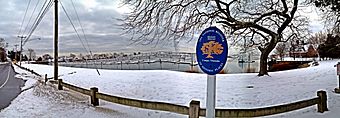Compo–Owenoke Historic District facts for kids
Quick facts for kids |
|
|
Compo–Owenoke Historic District
|
|
 |
|
| Location | Roughly bounded by Gray's Creek, Compo Rd. S. and Long Island Sound, Westport, Connecticut |
|---|---|
| Area | 154 acres (62 ha) |
| Architect | Sanford Evans; Ernest G. Southey |
| Architectural style | Colonial Revival, Bungalow/Craftsman, Queen Anne |
| MPS | Westport MPS |
| NRHP reference No. | 91000393 |
| Added to NRHP | April 19, 1991 |
The Compo–Owenoke Historic District is a special area in Westport, Connecticut. It's known for being a popular summer beach community from the early 1900s. Many of the buildings here were built between 1910 and 1940. This district has some of the best examples of old resort architecture in the whole region. It covers about 154 acres and was added to the National Register of Historic Places in 1991.
Contents
What Makes Compo–Owenoke Special?
The Compo and Owenoke areas are located on a peninsula that stretches into Long Island Sound. Compo Cove is to the east, and Gray's Creek is to the west. This historic district includes most of the land south of Compo Road South. It mostly excludes buildings that were built or changed a lot after 1940.
A Look at the Neighborhood
The Compo area is just north of Compo Beach. It has a street layout that looks a bit like a grid, with many small properties. Owenoke Point is a piece of land that sticks out to the west from Compo. Part of Owenoke was once an island. It was connected to the mainland with new land in the 1930s.
Styles of Homes You'll See
The houses in the district are mainly in styles like Colonial Revival, Tudor Revival, or Craftsman/Bungalow. You might even spot a few old farmhouses from the 1800s. These older homes are a reminder that this area was once farmland.
How Compo–Owenoke Became a Resort
Before it became a popular summer spot, Compo was a farming area near the coast. In 1909, things started to change. Development began on the eastern part of the district. This land used to be a farm owned by David Bradley.
Building the Community
New roads were built on the western side of the district in 1919. Later, Appletree Trail was added through the middle of the area in 1928. The beach itself was developed with places for swimming and dancing. There was also a marina for boats.
A Place for Summer Fun
The Compo–Owenoke area became very popular with middle-class New Yorkers in the 1920s. People came here for their summer vacations. Interestingly, most properties had rules that prevented big hotels from being built. This helped keep the area feeling like a charming community rather than a busy tourist hub.



